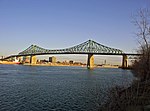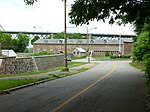Ednör – L'Attaque
Inverted roller coastersLa Ronde (amusement park)Operating roller coastersRemoved roller coastersRoller coasters in Quebec ... and 6 more
Roller coasters introduced in 1999Roller coasters introduced in 2010Roller coasters manufactured by VekomaRoller coasters operated by Six FlagsRoller coasters that closed in 2005Steel roller coasters

Ednör – L'Attaque is a steel inverted roller coaster at La Ronde in Montreal, Quebec, Canada. Built by Vekoma, it is a standard 689-meter Suspended Looping Coaster (SLC). It debuted in 1999 as Serial Thriller at Six Flags AstroWorld in Houston, Texas. Following the closure of AstroWorld in 2005, Serial Thriller was dismantled and moved to Six Flags Great Escape and Hurricane Harbor in Queensbury, New York. After sitting idle in New York for four years, it was relocated to La Ronde and opened for the 2010 season.
Excerpt from the Wikipedia article Ednör – L'Attaque (License: CC BY-SA 3.0, Authors, Images).Ednör – L'Attaque
Pont Jacques-Cartier, Montreal Ville-Marie
Geographical coordinates (GPS) Address Website Nearby Places Show on map
Geographical coordinates (GPS)
| Latitude | Longitude |
|---|---|
| N 45.5259 ° | E -73.5367 ° |
Address
La Ronde
Pont Jacques-Cartier 22
H3C 6A3 Montreal, Ville-Marie
Quebec, Canada
Open on Google Maps









